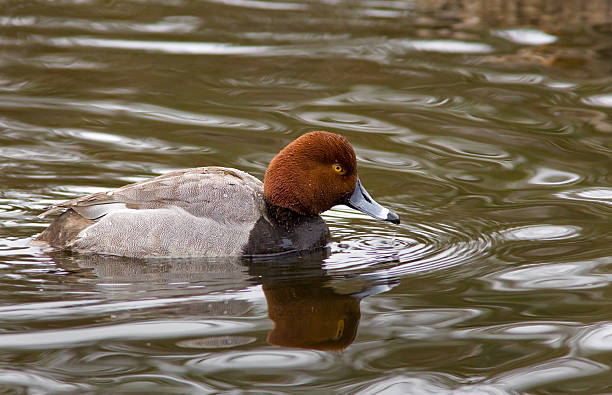ANIMAL: Redhead Aythya americana Type of Animal: Duck Habitat: Nonforested environments w/ water areas having permanent/fairly dense vegetation, prairies, marshes, freshwater ponds, reservoirs, streams, rivers, lakes, wetlands, river pools, bays, estuaries, lagoons, playa wetlands, freshwater river deltas, boreal forest lakes Location(s): SE Alaska, S Canada, SW & SC NW Territories, continental US, Mexico, Guatemala, Cuba, Bahamas. Vagrant in other Caribbean islands. Appearance: Breeding males have copper-red head/neck, black breast, gray back/sides, white belly, light black tail/rump, pale black-tipped blue bill, nonbreeding eclipse males have brown heads, females have yellow to brown head/neck, brown breast, white belly, gray to brown body, slate dark-tipped bill Food/Diet: Aquatic plants, seeds, grasses, weeds, stems, leaves, roots, rhizomes, vegetables, algae, aquatic insects, insect larvae, mollusks, fish eggs, small fish Status in Wild: Stable Conservation: Carefully managed hunting seasons & work to restore prime duck habitat. Breeding in zoos, aquariums, aviculture, & wildlife centers. Lifestyle: Flocks of 24-60,000 birds. Additional Info: Called: Male: Drake Female: Hen Young: Duckling Group: Flock Weight: Male: 2.4 lbs Female: 2.1 lbs Young: 9 oz Gestation: 1 month Life Span: 10 years Height: 1.5 ft Body Length: 1.375-1.775 ft Tail Length: 0.4 in Main predators of adults are otters, skunks, raccoons, bears, canids, badgers, mink, raptors, corvids, felids, large snakes, crocodilians, weasels, snapping turtles, & northern pike. Magpies, gulls, snakes, opossums, largemouth bass, & herons eat ducklings Female redheads either lay eggs in own nests, lay eggs in other female nests, and/or lay eggs in own & other nests. Younger inexperienced females more likely to parasitize other nests. Brood parasitism more common in poorer conditions. They’ll also lay eggs in nests of other duck species as well as those of American Bitterns & even of predatory Northern Harrier Hawks. Females usually lay 9-14 eggs. Ducklings stay w/ mom until 2.5 months. Like all ducks, waterproof feathers keep them warm & dry. They have 2.75 ft wingspan. They’ll feed by diving & by dabbling/upending. Males often molt after breeding, rendering them flightless until new feathers grown in. Also called Redhead Pochard. During courtship, males perform gymnastic “head throw” display, bending nearly in half w/ neck bent far over back until head touches tail. Then he snaps neck forward giving catlike call. Reach sexual maturity at 10 months old. Fun Fact(s): These ducks very popular w/ duck hunters due to attraction to decoys. In fact, they’ll often alight at hunting decoys before set up even finished. Females make quack sounds while males make catlike sounds.
